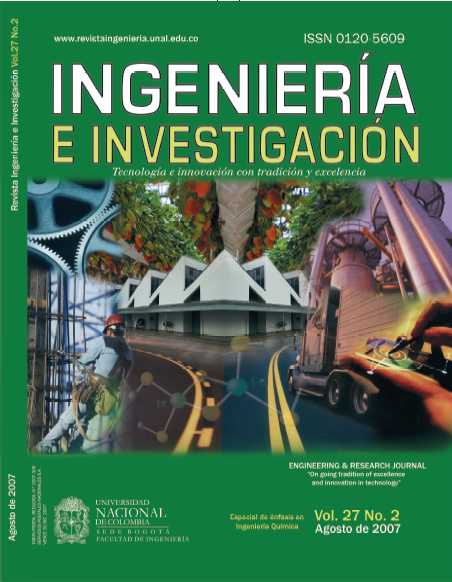Modelling, stability and biomechanical implications of three DOF passive bipedal gait
Modelamiento, estabilidad e implicaciones biomecánicas de la caminata bípeda pasiva con tres grados de libertad
DOI:
https://doi.org/10.15446/ing.investig.v27n2.14833Keywords:
passive gait, kneed passive walker, human gait (en)caminata pasiva, caminador pasivo con rodilla, marcha humana (es)
Downloads
Passive dynamic walkers can achieve a steady gait down an inclined plane simply by the influence of gravity.
This article presents the modelling of a 3 DOF passive bipedal walker, searching for a relationship between gait characteristics, the robot's physical properties and the slope of the plane. The proposed adimensional dynamical model’s equations are also given, implementing and modelling the dynamics is described and the main results are presented. Limits on robotic parameters leading to establishing stable limit cycles are also analysed as periodic doubling bifurcations appear to be natural in passive gait. Interesting results arose when comparing natural passive walking with human bipedal locomotion.
Los caminadores bípedos pasivos pueden lograr una caminata estable descendiendo por un plano inclinado solamente bajo la influencia de la atracción gravitacional. Este artículo presenta el modelamiento de un caminador bípedo pasivo de tres grados de libertad, buscando la relación entre las características de la caminata, las propiedades físicas del robot y la inclinación del plano. Se incluyen las ecuaciones del modelo dinámico adimensional propuesto para estudiar el caminador, se describen el proceso de implementación y modelamiento y los principales resultados obtenidos. Se analizan también los limites en los parámetros del robot que permiten obtener ciclos límites estables, ya que aparecen bifurcaciones dobles periódicas que aparentemente son naturales en la caminata pasiva. Finalmente, se hallan resultados interesantes cuando se compara la caminata natural pasiva con la locomoción bípeda humana.
References
Coleman, M., A stability study of a three-dimensional passive-dynamic model of human gait., Tesis presentada a Cornell University, para optar al título de Ph. D., 1998.
García, M., Stability, scaling and chaos in passive - dynamic gait models., Tesis presentada a Cornell University, para optar al título de Ph. D., 1999.
García, M., Chatterjee, A., Ruina, A. and Coleman, M., The simplest walking model: stability, complexity and scaling., ASME J. Biomechanical Engineering, Vol.120, No.2, 1998, pp. 281-288. DOI: https://doi.org/10.1115/1.2798313
Goswami, A., Espiau, B. y Keramane, A. Limit cycles and their stability in a passive bipedal gait., Proc. Int. Conf. Robotics and Automation - ICRA, 1996a.
Goswami, A., Thuilot, B. and Espiau, B. Compass - like biped robot. Part I: stability and bifurcation of passive gaits, Research Report, INRIA (Institut Nacional de Recherche en Informatique et en Automatique), 1996b.
McGeer, T., Passive dynamic walking, Int. J. of Robotic Research., Vol. 9, No.2, 1990, pp. 62 - 82. DOI: https://doi.org/10.1177/027836499000900206
Ramírez, A., Garzón, D., Roa M. and Cortés, C. Test on Patient of Damper Device for Lower Limb Prosthetic., Gait & Posture, Vol.22, Sup.1, 2005, pp. S48.
Roa, M. Modelamiento y simulación de la caminata bípeda., Tesis presentada a la Universidad Nacional de Colombia, para optar al título de Maestría en Automatización Industrial, 2004.
Roa, M., Ramírez, R. y Garzón, D., Development of Biped Robots at the National University of Colombia, Proc. 8th Int. Conf. on Climbing and Walking Robots - CLAWAR, 2005. DOI: https://doi.org/10.1007/3-540-26415-9_43
Winter, D. Biomechanics of human movement., John Wiley & Sons, 1979.
Yamakita, M. y Asano, F., Extended passive velocity field control with variable velocity fields for a kneed biped, Advanced Robotics., Vol. 115, No.2, 2001, pp. 139 - 168. DOI: https://doi.org/10.1163/15685530152116209
How to Cite
APA
ACM
ACS
ABNT
Chicago
Harvard
IEEE
MLA
Turabian
Vancouver
Download Citation
License
Copyright (c) 2007 Máximo Alejandro Roa Garzón, Camilo Villegas, Diego Alexander Garzón Alvarado

This work is licensed under a Creative Commons Attribution 4.0 International License.
The authors or holders of the copyright for each article hereby confer exclusive, limited and free authorization on the Universidad Nacional de Colombia's journal Ingeniería e Investigación concerning the aforementioned article which, once it has been evaluated and approved, will be submitted for publication, in line with the following items:
1. The version which has been corrected according to the evaluators' suggestions will be remitted and it will be made clear whether the aforementioned article is an unedited document regarding which the rights to be authorized are held and total responsibility will be assumed by the authors for the content of the work being submitted to Ingeniería e Investigación, the Universidad Nacional de Colombia and third-parties;
2. The authorization conferred on the journal will come into force from the date on which it is included in the respective volume and issue of Ingeniería e Investigación in the Open Journal Systems and on the journal's main page (https://revistas.unal.edu.co/index.php/ingeinv), as well as in different databases and indices in which the publication is indexed;
3. The authors authorize the Universidad Nacional de Colombia's journal Ingeniería e Investigación to publish the document in whatever required format (printed, digital, electronic or whatsoever known or yet to be discovered form) and authorize Ingeniería e Investigación to include the work in any indices and/or search engines deemed necessary for promoting its diffusion;
4. The authors accept that such authorization is given free of charge and they, therefore, waive any right to receive remuneration from the publication, distribution, public communication and any use whatsoever referred to in the terms of this authorization.



























